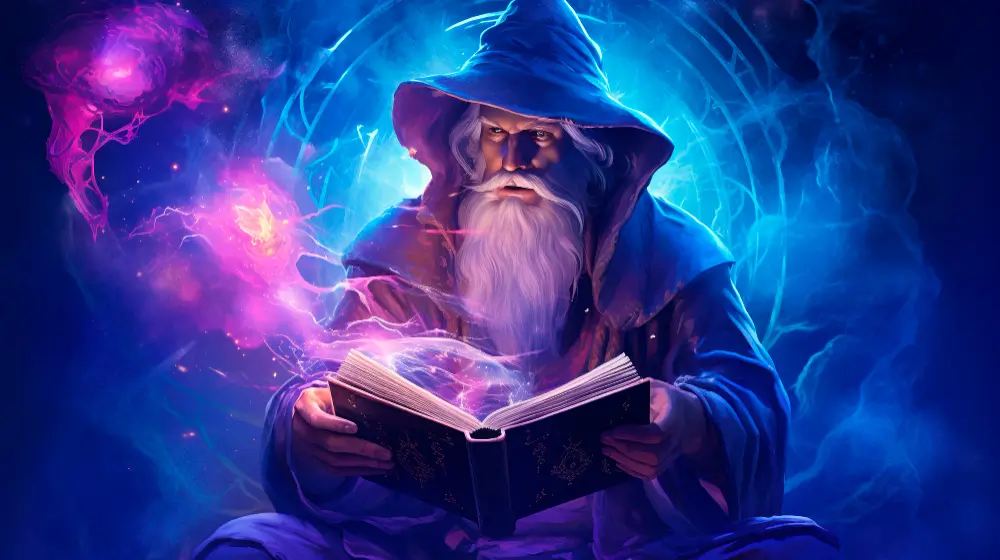
Gandalf the Grey, later known as Gandalf the White, stands as one of literature’s most inspiring examples of wisdom, courage, and unwavering dedication to the forces of good. Throughout J.R.R. Tolkien’s Middle-earth saga, this legendary wizard embodies the power of guidance without domination, strength tempered by compassion, and the profound understanding that even the smallest actions can change the course of the world. These Gandalf affirmations draw from his extraordinary journey as a guardian of Middle-earth, his belief in the potential of all free peoples, and his demonstration that true leadership comes from serving others rather than seeking power for oneself.
The enduring appeal of Gandalf lies in his embodiment of the archetypal wise mentor who combines immense power with deep humility, ancient knowledge with genuine care for individuals, and unwavering purpose with patient understanding. His approach to challenges—whether facing the Balrog in the depths of Moria or guiding the Fellowship through their darkest hours—demonstrates that courage is not the absence of fear, but the determination to do what is right despite that fear. Through his sacrifices and resurrections, his guidance and protection, Gandalf shows us that the greatest magic lies not in spells or power, but in the ability to inspire hope and kindle the light of goodness in others.
These Gandalf affirmations will help you cultivate the same wisdom, courage, and moral clarity that made this character such a beloved guide and protector:
• Embrace your role as a guide and mentor to others, understanding that true leadership means empowering people to discover their own strength and wisdom • Trust in the power of hope and perseverance, knowing that even in the darkest times, light can be found and victory is possible through determined effort • Practice patience and understanding when dealing with others, recognizing that everyone has their own pace of growth and their own unique contributions to make • Stand firm against evil and corruption while maintaining compassion for those who have lost their way or been deceived by darkness • Use your knowledge and abilities in service of the greater good, never seeking power for its own sake but always for the protection and welfare of others • Believe in the potential of all people, especially those who seem small or insignificant, understanding that courage and goodness can emerge from the most unlikely sources • Maintain your sense of wonder and joy even in difficult circumstances, finding moments of beauty and celebration amidst struggle and hardship • Accept that some battles require great sacrifice, but trust that such sacrifices are never in vain when made for the sake of love and justice • Cultivate wisdom through both study and experience, understanding that true knowledge comes from combining learning with compassionate action
Whether you’re facing personal challenges, seeking to guide others, or simply striving to live with greater purpose and wisdom, these Gandalf affirmations will remind you of the extraordinary power that comes from combining strength with humility, knowledge with compassion, and determination with hope.
25 Best Gandalf Affirmations
- Like Gandalf, I use my wisdom and strength to guide and protect those who cannot protect themselves.
- I face darkness and adversity with courage, knowing that hope and determination can overcome even the greatest evil.
- My purpose is to serve the greater good, using my abilities to kindle light and hope in others rather than seeking power for myself.
- I believe in the potential of all people, especially those who seem small or insignificant in the eyes of the world.
- Like Gandalf, I understand that true strength comes from wisdom, compassion, and the willingness to sacrifice for others.
- I maintain patience and understanding when guiding others, allowing them to discover their own courage and capabilities.
- My knowledge and experience are gifts that I share freely to help others navigate their own journeys toward growth and fulfillment.
- I stand firm against corruption and evil while maintaining hope for redemption and the possibility of positive change.
- Like Gandalf, I recognize that even the smallest actions can have profound consequences and the power to change the world.
- I embrace my role as a mentor and guide, understanding that true leadership means empowering others to become their best selves.
- My courage grows stronger in the face of overwhelming odds, knowing that righteous causes are worth fighting for regardless of the cost.
- I find joy and wonder in simple pleasures, maintaining my sense of celebration and appreciation for life’s beauty even during difficult times.
- Like Gandalf, I understand that some battles require great sacrifice, but that such sacrifices are never made in vain when done for love.
- I trust in the power of friendship and fellowship, knowing that together we can accomplish far more than we ever could alone.
- My wisdom comes not just from knowledge but from experience, compassion, and a deep understanding of the hearts of others.
- I carry the light of hope within me, sharing it with others who have lost their way in darkness or despair.
- Like Gandalf, I believe that mercy and forgiveness have the power to transform even the most hardened hearts and corrupt minds.
- I approach each challenge with both careful planning and willingness to adapt, understanding that flexibility and wisdom go hand in hand.
- My legacy will be measured not by my own achievements but by the courage and goodness I inspire in others.
- I remain humble despite my abilities and knowledge, understanding that true power lies in service rather than domination.
- Like Gandalf, I see beyond immediate appearances to recognize the potential for greatness in unexpected places and people.
- I persevere through setbacks and apparent defeats, trusting that persistence and faith can ultimately triumph over despair.
- My words carry weight and wisdom, and I use them carefully to encourage, guide, and inspire rather than to manipulate or control.
- I understand that some journeys must be taken alone, but I ensure that those I care about know they have my support and guidance when needed.
- Like Gandalf, I believe that the love of good and beautiful things is one of the most powerful forces against darkness and corruption in the world.
We recommend the following books for self improvement:

365 (+1) Affirmations to Supercharge Your Life
The one-of-a-kind program contained in this affirmation book, adorned with beautiful and colorful artworks, is meticulously designed to be wholeheartedly embraced by your subconscious mind, enabling you to manifest the life you desire.
Buy on Amazon
Small Habits Revolution: 10 Steps To Transforming Your Life Through The Power Of Mini Habits
If you're frustrated by failed attempts to adopt new habits, there's good news. The solution is within your grasp. This fast-moving guide provides actionable advice that will help you to make positive, purposeful, lasting changes in your life.
Buy on Amazon
Embrace What You Can’t Change
"Embrace What You Can’t Change" by the insightful duo Ahiranta Rinpoche and Ozay Rinpoche is a transformative guide that invites readers to navigate the complexities of life with grace and acceptance.
Buy on Amazon
We Can Do Better: A Self-Help Book for People Who Are Tired of Self-Help Books
We Can Do Better isn’t another book telling you to hustle harder or wake up at 5 a.m. It’s not about fixing yourself — it’s about finally giving yourself permission to stop performing and start feeling human again.
Buy on Amazon
The P.R.I.M.E.R. Goal Setting Method
Amazon bestselling author Damon Zahariades provides a clear, concise, and actionable system for accomplishing anything you set out to do. You'll learn how to approach goal setting in a way that practically guarantees success. Along the way, you'll experience a massive boost in self-confidence. After achieving goal after goal, you'll begin to anticipate success as a foregone conclusion.
Buy on AmazonThis post contains affiliate links. As an Amazon Associate, we earn from qualifying purchases at no additional cost to you.
Gandalf: Inspirational Quotes
The profound wisdom of Gandalf resonates throughout J.R.R. Tolkien’s Middle-earth saga, offering timeless insights into courage, hope, the nature of power, and the importance of standing against evil. These carefully selected quotes from “The Hobbit” and “The Lord of the Rings” capture the essence of Gandalf’s philosophy and his deep understanding of what it means to fight for good in a world threatened by darkness. Each quote reflects his role as a guide, protector, and beacon of hope for all free peoples of Middle-earth.
- “All we have to decide is what to do with the time that is given us.”
- “A wizard is never late, nor is he early, he arrives precisely when he means to.”
- “I will not say: do not weep; for not all tears are an evil.”
- “Many that live deserve death. And some that die deserve life. Can you give it to them? Then do not be too eager to deal out death in judgement.”
- “It is the small everyday deeds of ordinary folk that keep the darkness at bay. Small acts of kindness and love.”
- “Courage is found in unlikely places.”
- “He that breaks a thing to find out what it is has left the path of wisdom.”
- “I am looking for someone to share in an adventure that I am arranging, and it’s very difficult to find anyone.”
- “The wide world is all about you: you can fence yourselves in, but you cannot forever fence it out.”
- “Even the very wise cannot see all ends.”
- “There is nothing like looking, if you want to find something. You certainly usually find something, if you look, but it is not always quite the something you were after.”
- “It is not our part to master all the tides of the world, but to do what is in us for the succour of those years wherein we are set.”
- “Despair is only for those who see the end beyond all doubt. We do not.”
- “I was talking aloud to myself. A habit of the old: they choose the wisest person present to speak to.”
- “The burned hand teaches best. After that advice about fire goes to the heart.”
- “You cannot pass!”
- “End? No, the journey doesn’t end here. Death is just another path, one that we all must take.”
- “White shores, and beyond, a far green country under a swift sunrise.”
- “Saruman believes it is only great power that can hold evil in check, but that is not what I have found. It is the small everyday deeds of ordinary folk that keep the darkness at bay.”
- “I am Gandalf the White. And I come back to you now at the turn of the tide.”
- “The treacherous are ever distrustful.”
- “Do not meddle in the affairs of Wizards, for they are subtle and quick to anger.”
- “May it be a light to you in dark places, when all other lights go out.”
- “True courage is about knowing not when to take a life, but when to spare one.”
- “Follow your nose.”
History of Gandalf
Gandalf emerged from J.R.R. Tolkien’s imagination as one of the central figures in his Middle-earth legendarium, first appearing in “The Hobbit” (1937) and later playing a crucial role in “The Lord of the Rings” trilogy. The character was conceived during Tolkien’s development of his fictional world in the 1930s, drawing from his extensive knowledge of mythology, linguistics, and ancient literature to create a figure that embodied the archetypal wise wizard while possessing unique characteristics that made him distinctly Tolkienian.
The origins of Gandalf can be traced to Tolkien’s fascination with Norse mythology, particularly the figure of Odin, who was known for wandering Middle-earth in the guise of an old man with a staff and broad-brimmed hat. However, Tolkien transformed this mythological inspiration into something entirely new, creating a character who was not a god in disguise but one of the Maiar, divine spirits sent to Middle-earth to guide and protect the free peoples against the growing threat of evil.
In Tolkien’s carefully constructed mythology, Gandalf is revealed to be one of the Istari, or wizards, sent by the Valar (the angelic powers governing the world) to oppose the Dark Lord Sauron. His true name is Mithrandir among the Elves, Tharkûn to the Dwarves, and Incánus in the South, but he is known as Gandalf to the Hobbits and Men of the North. This multiplicity of names reflects Tolkien’s linguistic interests and his belief that names carry deep meaning and power.
The character’s development throughout Tolkien’s works shows a careful balance between power and restraint. Unlike typical fantasy wizards who rely heavily on magic spells and dramatic displays of power, Gandalf’s strength lies primarily in his wisdom, his ability to inspire others, and his deep understanding of the hearts and minds of the people he encounters. His magic, when displayed, is often subtle and focused on guidance, protection, and the kindling of hope rather than destruction or domination.
Gandalf’s most significant character arc occurs in “The Lord of the Rings,” where his apparent death in Moria and subsequent return as Gandalf the White represents not just a plot device but a profound spiritual transformation. His sacrifice for the Fellowship and his resurrection demonstrate the themes of death and renewal that are central to Tolkien’s work, reflecting the author’s Christian faith and his belief in the ultimate triumph of good over evil.
The character serves multiple functions within Tolkien’s narrative structure: he is a guide for the heroes, a protector of the innocent, a bearer of ancient wisdom, and a catalyst for the growth and development of other characters. His relationships with Bilbo and Frodo Baggins, in particular, demonstrate his ability to see potential in the most unlikely heroes and his faith in the power of mercy and compassion to overcome hatred and fear.
Through Gandalf, Tolkien explored themes of leadership, sacrifice, and the responsible use of power. The wizard’s consistent refusal to take the One Ring when offered, and his warning about the corrupting nature of power, reflect Tolkien’s own concerns about authority and the dangers of seeking power for its own sake. Gandalf represents the ideal of power used solely in service of others, never for personal gain or glory.
Who and When Made Gandalf
John Ronald Reuel Tolkien, born in Bloemfontein, South Africa, in 1892 and raised in England, created Gandalf during the development of his Middle-earth mythology in the early 20th century. Tolkien, a professor of Anglo-Saxon studies at Oxford University, drew upon his extensive knowledge of ancient languages, mythology, and literature to craft not just a character but an entire world with its own history, languages, and cultures.
The creation of Gandalf began in the late 1920s and early 1930s when Tolkien was writing “The Hobbit” as a story for his children. Initially conceived as a somewhat mysterious wizard who helps Bilbo Baggins on his adventure, Gandalf evolved significantly as Tolkien developed the broader mythology of Middle-earth. The character was influenced by various sources, including Wagner’s “Der Ring des Nibelungen,” Norse mythology (particularly Odin the Wanderer), and Tolkien’s own invented languages and histories.
Tolkien’s background as a philologist and medievalist profoundly influenced Gandalf’s creation. The wizard’s various names in different languages of Middle-earth reflect Tolkien’s belief that language shapes culture and identity. The author spent years developing not just the character but the entire cosmology in which Gandalf existed, creating detailed histories, genealogies, and linguistic systems that gave depth and authenticity to his fictional world.
“The Hobbit” was published in 1937 by George Allen & Unwin, introducing Gandalf to the world as a mysterious and powerful wizard who arrives unexpectedly and sets great adventures in motion. The book’s success led to requests for a sequel, which eventually became “The Lord of the Rings,” published in three volumes between 1954 and 1955. In this larger work, Gandalf’s character was greatly expanded and his true nature as one of the Maiar was revealed.
The intellectual property surrounding Gandalf has grown exponentially since Tolkien’s original works. The character has appeared in numerous adaptations, most notably Peter Jackson’s film trilogies “The Lord of the Rings” (2001-2003) and “The Hobbit” (2012-2014), where he was portrayed by Sir Ian McKellen. These films introduced Gandalf to a global audience of millions and cemented his status as one of cinema’s most beloved fantasy characters.
Beyond the films, Gandalf has appeared in numerous other media adaptations, including radio dramas, stage productions, video games, and animated features. The character has been featured in various board games, role-playing games, and merchandise, making him one of the most recognizable figures in fantasy literature and popular culture.
The influence of Gandalf on subsequent fantasy literature cannot be overstated. The character established many of the conventions for wise mentor figures in fantasy fiction, influencing countless authors from Terry Pratchett to J.K. Rowling. The archetype of the powerful but humble wizard who guides heroes rather than overshadowing them has become a staple of the fantasy genre.
Academic study of Tolkien’s works, including detailed analysis of Gandalf’s character and role, has flourished since the 1960s. The Tolkien Society, founded in 1969, continues to promote scholarship and appreciation of Tolkien’s works, while numerous universities offer courses examining Middle-earth and its inhabitants. Gandalf’s character has been analyzed from multiple perspectives, including literary criticism, religious studies, and mythology.
The global success of Tolkien’s works has made Gandalf one of the most recognizable fictional characters in the world. His influence extends beyond literature into discussions of leadership, mentorship, and moral philosophy. The character’s combination of power and humility, wisdom and compassion, continues to inspire readers and viewers across cultures and generations.
Tolkien’s creation has also influenced modern fantasy gaming, with Gandalf serving as the inspiration for countless wizard characters in role-playing games, video games, and other interactive media. The character’s distinctive appearance—grey robes, pointed hat, long beard, and staff—has become the archetypal image of a fantasy wizard in popular culture.
Why We Love Gandalf
Our enduring love for Gandalf stems from his embodiment of the ideal mentor and guide who combines immense power with genuine humility and deep compassion. He represents the archetype of the wise counselor who empowers others to discover their own strength rather than overshadowing them with his abilities. His willingness to sacrifice himself for others, combined with his faith in the potential of even the smallest and most unlikely heroes, resonates with our deepest aspirations for leadership and service.
Gandalf appeals to readers and viewers because he demonstrates that true strength lies not in domination or the display of power, but in the ability to inspire hope, kindle courage in others, and guide them toward their own heroic potential. His patient mentorship of Frodo, his friendship with the humble Hobbits, and his respect for all free peoples regardless of their station show us a model of leadership based on service rather than authority.
Perhaps most importantly, Gandalf represents the triumph of wisdom over force, compassion over cruelty, and hope over despair. His unwavering belief that good will ultimately prevail, even in the darkest times, offers comfort and inspiration to those facing their own struggles. He reminds us that every person has a role to play in the great story of life and that even the smallest actions, when performed with courage and love, can change the world.
His enduring popularity reflects our need for figures who embody both power and restraint, showing us that the greatest magic lies in the ability to see the best in others and help them become the heroes of their own stories.
Interesting Facts about Gandalf
- True Name: Gandalf’s true name is Olórin, given to him in Valinor before he came to Middle-earth as one of the Maiar.
- Multiple Names: He is known by different names to different peoples: Mithrandir to the Elves, Tharkûn to the Dwarves, and Incánus in the South.
- Age: Gandalf is thousands of years old, having existed since before the creation of the world, though he only came to physical form in Middle-earth around 1000 T.A.
- Narya the Red: He bears one of the three Elven Rings of Power, Narya, given to him by Círdan the Shipwright to aid in his mission.
- Smoking Habit: Gandalf is credited with introducing pipe-weed (tobacco) smoking to the Shire, sharing this pleasure with the Hobbits.
- Restriction on Power: The Istari were forbidden from matching Sauron’s power with power, required instead to guide and counsel the free peoples.
- Resurrection: After his battle with the Balrog, Gandalf died and was sent back by Eru Ilúvatar (God) as Gandalf the White with enhanced power.
- Shadowfax: His horse Shadowfax was the lord of all horses and could understand speech, given to him by Théoden of Rohan.
- Glamdring: His sword Glamdring (“Foe-hammer”) was forged in Gondolin and was originally wielded by Turgon, King of Gondolin.
- Fear of Fire: Despite his power, Gandalf shows concern about facing the Balrog, a creature of shadow and flame, in Moria.
- Ian McKellen’s Portrayal: Sir Ian McKellen’s iconic portrayal in Peter Jackson’s films brought Gandalf to life for millions of viewers worldwide.
- Fireworks Master: In “The Hobbit,” Gandalf is famous for his spectacular fireworks displays, delighting the Hobbits with his pyrotechnics.
- White Council: Gandalf was a member of the White Council alongside Saruman, Elrond, and Galadriel, formed to oppose the growing darkness.
- The Grey Pilgrim: He was known as the Grey Pilgrim for his constant wandering throughout Middle-earth, gathering information and providing aid.
- Departed with Frodo: At the end of “The Lord of the Rings,” Gandalf sails from the Grey Havens to the Undying Lands with Frodo, Elrond, and Galadriel.








